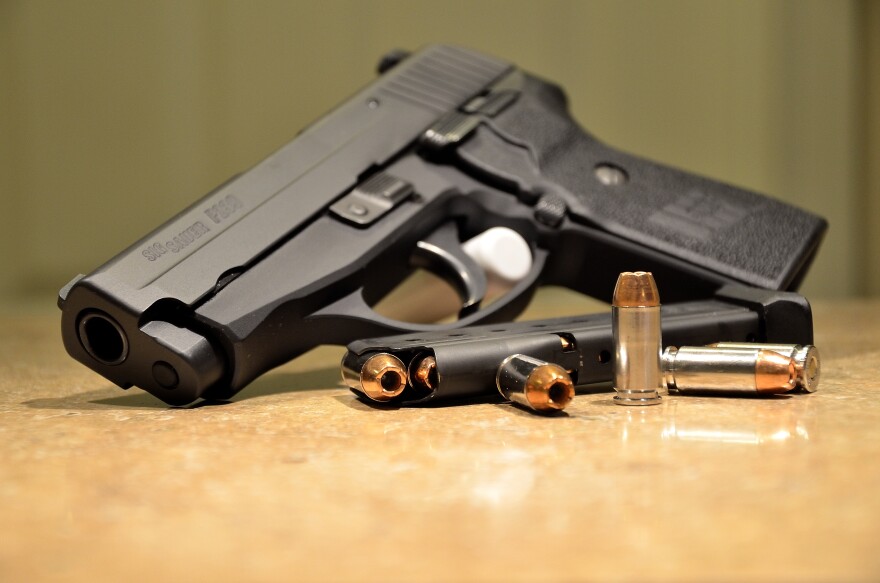Before seven-year-old Dequante Hobbs Jr. was hit by a stray bullet in his kitchen on May 21, he called his mom. She was in the next room.
“I was like, ‘Why are you calling me? We’re in the same house. I’m right here,’” Micheshia Norment, Dequante’s mother, said. “He’s like, ‘Mommy I was just calling to tell you wait a minute, I’ll be ready to take a bath … I’ve got a field day tomorrow.'”
But first, Dequante went to the kitchen for a snack. He had just finished a piece of cake and was watching videos about assembling speakers on his tablet. Then, a stray bullet went through the window.
Dequante died hours later at Norton Children’s Hospital, a young victim of gun-related violence.
Nationally, more than 7,000 children are shot every year, and many are similar to Dequante.
That means every day in America, an average of 19 children are shot and three of them will die from their injuries. Like Dequante, most are boys, most are black, and many of them are shot at home.
That’s according to a study from the Centers for Disease Control and Prevention, published Monday, which compiled federal and state data from 2002 to 2014.
The report paints a grim picture of firearm-related deaths in the United States. Previous research has indicated that among the world’s high income countries, the U.S. accounts for 91 percent of gun-related deaths among kids under 14 years old.
From 2012 to 2014, nearly 1,300 children died every year from firearm-related injury, about three deaths per day. An additional 5,790 kids were medically treated for firearm-related injuries annually over the same time period, according to the report.
Homicides, like Dequante’s, accounted for more than half of those deaths. Homicide rates for black children were almost 10 times higher than rates for white or Asian-American children. Eighty-five percent of younger kids were killed in their home, and children Dequante’s age died as bystanders at double the rates compared to those age 13-17, data show.
“Younger children are often ‘caught in the crossfire,’ whether as innocent bystanders to community violence or during incidents of intimate partner violence and family conflict,” the study said.
'There's something going on in Kentucky'
In Kentucky, the statistics are similar to what’s in the CDC’s study, but there are some differences.
Sabrina Brown is the principal investigator for Kentucky’s violent death reporting system. She said 8 percent of homicides in Kentucky between 2005 and 2014 involved children under the age of 17, often victims of an argument or what she classifies as "intimate partner violence." Unlike the CDC study, females in Kentucky are twice as likely to be killed by an intimate partner, and their deaths were more often related to abuse.
“There’s something going on in Kentucky that makes our female population more vulnerable to firearm-related fatalities,” Brown said.
Brown also said child suicides from firearm injuries in Kentucky defy national rates. The CDC defines child suicide as an intentional, self-inflicted gun death.
Nationally, boys are much more likely to kill themselves with guns. In Kentucky, boys and girls are almost equally likely to die by self-inflicted gun wounds.
But overall nationally, self-inflicted gun deaths among children are on the rise. The CDC study found from 2007 to 2014, the rate of children killed by others with guns fell, but the rate of children who killed themselves with guns skyrocketed by 60 percent.
Katherine Fowler, the CDC report’s lead researcher, said her study urges action to deter violence.
“The findings highlight the need for evidence-based solutions in all areas to address this public health problem,” she said. “Prevention efforts that address multiple risk and protective factors are essential to preventing violence.”
The study proposes gun safety measures, such as securely storing weapons, and programs to help children manage emotions and psychological factors which could lead them to suicide. For violence, the study recommends addressing poverty and other violent-promoting factors, and encourages street outreach approaches, school programs, early childhood education and therapeutic methods.
Remembering Dequante
Micheshia Norment doubts random child deaths like her son Dequante’s can be prevented, but says restricting firearms could stop the violence.
“The way the world is nowadays, you can’t stop anything,” Norment said. “We can do what we can to prevent it, but as long as shops — like pawn shops and all of that — are selling guns, it’s not going to stop.”
Though his demographics mirror some national numbers, Dequante was more than just a statistic.
Norment said he was a "mama’s boy" and a gentleman to his sister, holding her hand and opening doors for her. Dequante loved school, often getting up an hour early to wait for the bus and, maybe, see his friend Carter.
He loved the cartoon "Paw Patrol." The show’s stickers still adorn his room’s walls, along with a clock with images of characters from the Disney movie “Cars.”
But Norment said the movie’s main character, Lightning McQueen, wasn’t Dequante’s favorite. He liked the fire truck Big Red more. She said her son seemed to see himself in the quiet fire truck because he often struggled with a speech development problem.
Norment plans to remember him Thursday by releasing Chinese lanterns into the sky. The ceremony starts at 7:30 p.m. at the Big Four Bridge in Waterfront Park, near the playground where Dequante liked to play.



